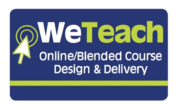WeTeach
Course Description
WeTeach is an interactive, collaborative course intended for instructors who teach online or blended courses. Instructors will become an online student in the course to develop their own online teaching skills. This course also allows instructors to share online teaching experiences and best practices. This course is for instructors who are new to online teaching. It is also for instructors looking to expand their skills, explore new ways to engage students, and use technology more effectively to save time.
Course Format
WeTeach is an eight-week course that consists of eight online modules with 1-hour weekly virtual meetings. Expect to spend eight to nine additional hours reviewing lectures/readings and completing assignments developed to strengthen your online teaching and design skills.
At the completion of the course, all participants will have the opportunity to receive up to 2 hours of individual instructional consultation related to WeTeach course topics with a Coach Consultant. Participation in instructional consultation is optional and is not required to receive the Certificate of Completion. The consultation hours are non-transferable and expire three months after the published course end date. The assignment of Coach Consultants, all of whom will be Quality Matters Master Reviewers, will be managed by Minnesota Online Quality Initiative Co-Coordinators.
Certificate of Completion Requirements
WeTeach offers the option earn a certificate of completion for completing the course. Below are the requirements for earning the certificate.
- Attend six out of the eight virtual meetings
- Complete all required assignments listed in syllabus
Course Learning Objectives
| 1.)Identify the proper MinnState Media Code
2.)Identify and discuss how to utilize D2L Brightspace tools |
3.)Discuss the difference between online and F2F courses
4.)Identify characteristics of your student population and online support services to meet their needs | |
| 5.)Discuss the Quality Matters (QM) rubric and review process
6.)Discuss the different between course design and delivery |
7.)Summarize key finding from literature related to a QM Standard
8.)Describe different tools used for online collaboration and communication | |
| 9.)Discuss the use of Collaborative Learning in online/blended courses
10.)Describe best practices for using a virtual room and online discussion boards |
11.)Discuss instructor presence techniques and best practices
12.)Discuss different instructional design models | |
| 13.)Write measurable learning objectives suitable for course level
14.)Discuss formative and summative assessment options for an online/blended course |
15.)Apply aligning learning objectives, learning activities, and assessments
16.)Apply learning activities and assessments that are sequenced and varied | |
| 17.)Apply Universal Design principles (ie. ADA Compliance)
18.)Define Copyright and Intellectual Property |
19.)Discuss the use of online assessment and feedback tools in D2L Brightspace
20.)Draft active learning activities and assignments for an online course | |
| 21.)Draft a clear grading policy and list activities and assessments contributing to final grade
22.)Define response time on communication and assignment feedback |
23.)Discuss interaction between student to student and student to instructor
24.)Create a rubric to evaluate student performance | |
| 25.)Discuss strategies to ensure academic integrity
26.)Explain how to transition face-to-face assignments online |
27.)Discuss options for integrating self-authored, publisher-provided, and open educational resources into online courses
28.)Create recorded lectures |
Course Modules
Below is a description of each module.Each module includes online readings, videos, articles, activities and assignments. Each module also includes a live virtual discussion and presentation.
MODULE 1: Charting Your Course & Student Support Services
Topics in this module provide an introduction to online teaching within the MinnState System. Topics include an overview of the tools available, course coding and identifying challenges and opportunities of delivery methods. In this module, we will also review access the characteristics of your student population and discuss campus support services and resources available to online students, including technical support, access services, and tutoring.
MODULE 2: Quality Matters & Alignment
In this module, you will be introduced to the Quality Matters (QM) process and rubric. We will discuss factors that impact the quality of online learning experiences and the importance of learning objective alignment. The QM process is just one of the frameworks used in course design for quality assurance in online course development. In this module we will also review QM educational research literature and take a closer look at some of the QM standards. MinnState is a Quality Matter subscriber.
MODULE 3: Communication & Collaboration Online
In this module, we will discuss several tools and strategies that can be used to communicate with your students online. They include tools for facilitating group work, team projects, and instructor presence online. We will cover tools such as D2L, Facebook, Twitter, and Zoom. We will also discuss how to set and communicate your expectations for online participation and netiquette, .
MODULE 4: Learning Objectives & Course Design Models
In this module, we will discuss different learning taxonomies and course design models. In the module you will start to map out components of your own online or blended course. We will also discuss and practice the process of writing effective and measurable learning objectives. Learning objectives help to define your expectations for students within the curriculum and the course. Well-written learning objectives are essential to instructional course design. Other topics in this module include Universal Design for Learning and developing a student-centered course orientation and navigation.
MODULE 5: Online Assignments Examples
Module 6: Feedback, Assignment Instructions & Rubrics
There are many different types of assignments that can be incorporated into an online course. This module will provide you with examples on how to move some of your face-to-face assignments into an online course. Examples include case studies, scenario-based discussion boards, student video assignments and debates.
Module 7: Instructional Materials
Topics in this module include content authoring, the use of publisher-provided content (e.g., ebooks, test banks), and the integration of open educational resources (OER). We will introduce you to several OER repositories and discuss Creative Commons licensing. We will also discuss the use of recorded lectures and video software.
